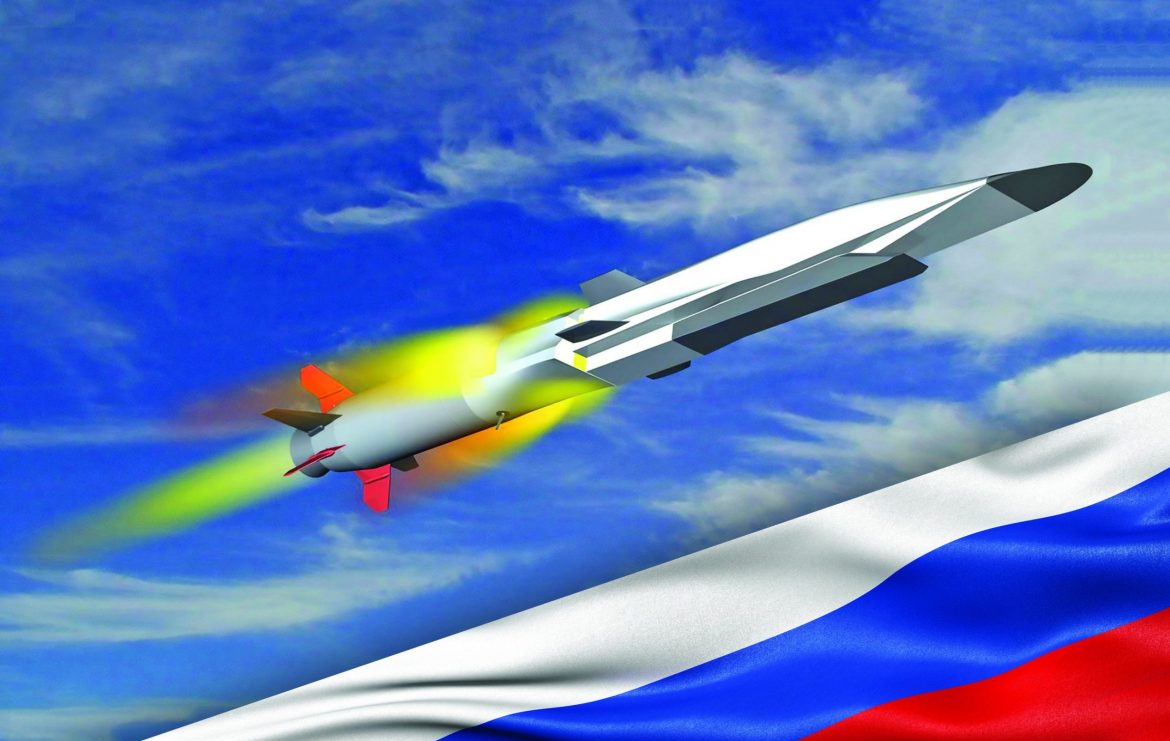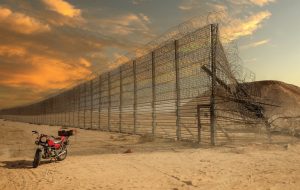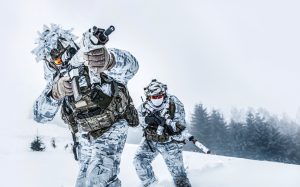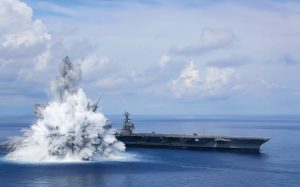As early as March 2018, Michael Griffin, U.S. Undersecretary for Research and Engineering, declared that hypersonic capabilities were his number one priority. In July 2020, Ellen M. Lord, Undersecretary of Defense for Acquisition and Sustainment re-emphasized that “Hypersonics and counter-hypersonics remain one of the Defense Department’s highest technical modernization priorities.” Russia and China claim to have fielded hypersonic weapons – the Kinzhal and DF-17 respectively. This short article will provide a primer on hypersonic (also known as hypervelocity) systems, then examine Russian, Chinese, and U.S. efforts in this area, and close with a brief examination of the operational impacts of hypersonics.
Primer on hypersonics
Hypersonic weapons are those that travel between Mach 5 (5,500 kilometers/hour) and Mach 25 (28,000 kilometers/hour). Today there are three types of weapons referred to as hypersonic.
1
Hypersonic boost-glide vehicles: They are boosted to speed and altitude by a rocket before gliding on top of the atmosphere to the target. Their primary advantage over ICBMs (Intercontinental Ballistic Missiles) is that they can maneuver during the glide phase so it is impossible to predict the target and interception is much more difficult. Boost-glide missiles will reach the top range of hypersonic speed and have intercontinental range. Illustration one shows the flight profile of a boost-glide missile.
2
Hypersonic cruise missiles: These missiles are powered by high-speed, air breathing engines known as scramjets. The weapons must be accelerated to close to Mach 5 before launch since scramjets only work at that speed and higher. With a speed of Mach 5 to Mach 8, they are significantly slower than boost-glide weapons but have the great advantage on not requiring a large booster to get them into space. As a result, they should be much cheaper and more prolific than boost-glide systems. Their current range is over 2,500 kilometers.
3
Gun-launched hypersonic weapons which travel at Mach 6 to Mach 8 with a range out to 160 kilometers. These weapons have a good deal of appeal since they can be fired from existing ground and naval artillery. Leveraging existing military systems speeds fielding of these systems and lowers costs.
The science and engineering of all forms of hypersonics remains extremely difficult. The extraordinary velocities involved create extreme temperature and violent airflows over flight surfaces. This requires new understanding of flight at that speed as well as new materials and designs.
Russian Hypersonics
Russia claims it is pursuing hypersonic weapons as a hedge against improving U.S. ballistic missile defenses combined with concerns that the United States will develop effective first strike capability against existing Russian nuclear weapons.
As a result, Russia is pursuing two hypersonic weapons programs. On 28 December 2018, it launched an ICBM with an Avangard glide body as the payload. Upon separation, it maneuvered for 6,000 km at Mach 27. The Avangard is designed as part of a MIRV (Multiple-Independent Reentry Vehicle) payload for an ICBM. It is believed to be capable of carrying either a conventional or two-megaton nuclear warhead. President Vladimir Putin has stated the system is operational.
Russia has also developed and tested the Kinzhal Air-Launched Ballistic Missile. With a reported range of 1,500-2,000 kilometers, a payload of 480 kg (nuclear or conventional), and a potential top speed of Mach 10, its trajectory is ballistic so does not maneuver after launch from the aircraft carrying it.
China’s Hypersonics
China has stated its efforts to develop hypersonics reflect concern that a combination of U.S. missile defense systems and emerging hypersonic weapons could enable the United States to conduct a pre-emptive strike against China’s nuclear deterrent.
In response, China is developing the DF-ZF Hypersonic Glide Vehicle. While it will primarily be deployed on the DF-17 missile (range 1,600-2,500 km), China may also be preparing to deploy it on the DF-21 (range 1,500-1,700 km) and DF-26 (range – 4,000 km) missiles. To provide increased range, China is developing the DF-41 ICBM which could deliver either a conventional or nuclear warhead to the United States’ mainland. China has also successfully tested the Xing Kong-2 a nuclear capable hypersonic vehicle but it is not expected to be operational until 2025.
China has invested heavily in the infrastructure necessary to build and test hypersonic vehicles. At the end of 2018, Michael Griffin, then Undersecretary of Defense for Research and Engineering stated that “China has tested more hypersonics weapons than we have in a decade.”
U.S. Hypersonics
As noted in the opening paragraph, the United States’ interest in hypersonic weapons has been reinvigorated at the top levels of the Pentagon. However, unlike the Russian and Chinese systems, U.S. hypersonics will only carry conventional weapons.
The U.S. Navy is leading development of Conventional Prompt Strike which pairs a common glide vehicle to a submarine-launched booster. Still in early stages of development, the Navy is not projecting initial operating capability (IOC) until 2028. The U.S. Army will use the same common glide vehicle and booster in its Long-Range Hypersonic Weapons program but on a much faster timeline. The Army hopes to field combat rounds with a range of 1,400 miles by 2023. The U.S. Air Force has successfully tested its hypersonic glide vehicle prototype as a concept demonstrator. The glide body will be incorporated into the AM-183 Air-Launched Rapid Response Weapon program for deployment from B-52s and possibly F-15s. The Defense Advanced Research Projects Agency is working with the Air Force on the Tactical Boost Glide hypersonic test vehicle to develop future air-launched, tactical boost glide systems. It is also leading the development of a Hypersonic Air-breathing Weapon Concept for smaller air-launched weapons.
The United States has developed and tested a family of hypervelocity cannon rounds. These rounds can be fired by existing 155mm artillery systems as well as the Mk 45 naval gun mounted on U.S. destroyers and cruisers. Depending on the weapon used, the rounds can reach out from 65 to 110 kilometers. They also have great potential as air defense weapons against both aircraft and cruise missiles.
Other nations
Australia, India, France, and Japan are all conducting research and development of hypersonic weapons. India paired with Russia in the development of the BrahMos II hypersonic cruise missile and plans initial operating capability (IOC) between 2025 and 2028. Australia has cooperated with the United States in the development of hypersonics and has seven hypersonic wind tunnels. France has collaborated with Russia and is working to modify its ASN4G missile for hypersonic flight. Japan has a program for both a hypersonic cruise missile and a hypersonic gliding projectile with expected fielding by 2030.
Defending against hypersonic weapons
Defence against hypersonic weapons is an extremely challenging technical problem that currently has no solution. The U.S. Missile Defense Agency is working on a variety of technologies to defend against hypersonic weapons to include interceptor missiles, hypervelocity projectiles, lasers, microwaves, and electronic attack systems.
Operational impact of hypersonic weapons
While both China and Russia seek hypersonic delivery of nuclear weapons, achieving that goal will not fundamentally change the current balance of nuclear deterrence. The difficulty of tracking these missiles in flight will raise the uncertainty and increase pressure on leaders to launch on warning. This has the potential to create instability in a crisis. However, as long as leadership in each nation is confident that it has a secure second-strike capability, the basic deterrent calculations have not changed.
In contrast, hypersonic weapons have the potential to dramatically change conventional conflicts. The speed, accuracy, and power of these weapons paired with the difficulty in defending against them means large fixed facilities may be extremely vulnerable. Yet as demonstrated by decades of U.S. precision strike.
Fixed facilities are already dramatically more vulnerable to conventional missiles. Therefore, these systems may well force militaries to rethink their basing and operational concepts.
Conclusion
The United States, Russia, and China are all investing heavily in hypersonics. Other nations are following suit on a smaller scale. This is part of a global trend driven by the emerging technologies of the Fourth Industrial Revolution. The convergence of these technologies is providing long-range, precision strike to a much wider group of states and even some non-state actors. While boost-glide weapons are likely to remain prohibitively expensive, cruise missiles may be more affordable. Hypervelocity cannon rounds will be much more affordable, and since they can be fired from existing systems, may be available sooner and widely deployed.
By: T. X. Hammes (Researcher in military affairs)













